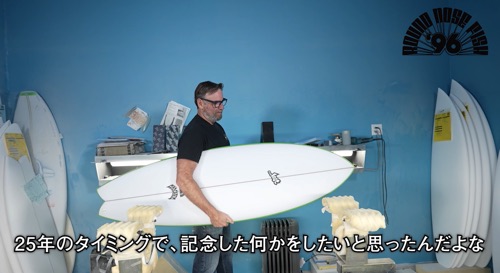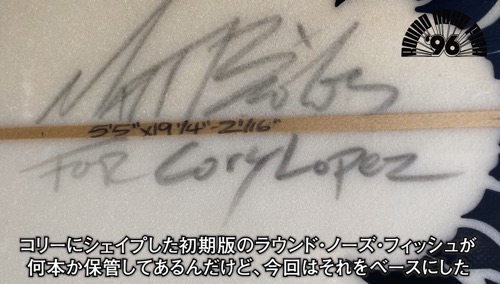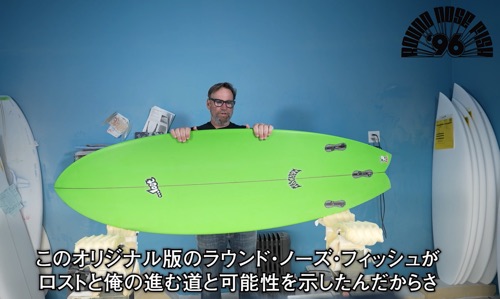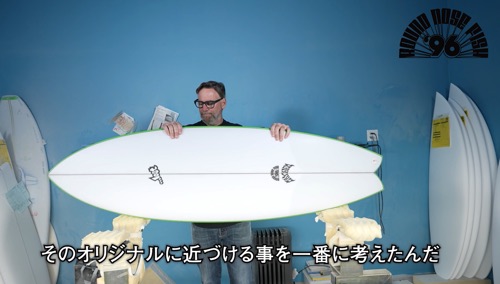Blog posts
WSLパイププロ QS2000 世界最強Lostチームライダーが男女ともに優勝!
ハワイのパイプラインで行われていたWSLパイププロQS2000 イベントで Lostチームが男女ともに優勝しました。 ウィンズは母親になり2026年ワールドツアーにカムバックする「カリッサ・ムーア」が優勝。 メンズは、優勝候補のJJフローレンスを含むハワイアン4人激戦のファイナルヒートを圧倒的なパフォーマンスで、 現在メンズCSランキングナンバーワンで彼もまた2026年ワールドツアーにカムバックする「イーライ・ハネマン」が優勝しました。 「イーライ」が乗っていたボードは、パイプラインやバックドアでほぼ全員のチームが乗っていWHIPLASHモデルです。
Learn more絶対見逃せないイベント『プレオーダー』が始まりましたよ! 『MICK’S TAPE』BLACK SHEEP BUILTを手にいれるチャンスです!
こんにちは。スタッフのコウヘイです。 前から個人的に勝手に言っている、NEXT『RNF’96』だと思っているイチオシモデル『MICKS TAPE』。 ストックボードはUSAもVIETNAMも全て完売で、現在はUSAカスタムオーダーでしか手にいれることが出来ない状況でしたが、先日始まった『プレオーダー』イベントで注文出来ますよ! 『MICK’S TAPE』はカスタムオーダーにて手に入れて2年近く経ちますが、いまだに1番気に入っており、1番出番が多いヘビロテボードですが、”Black Sheep Built”なので状態も良くとても気に入っております! その『MICK’S TAPE』が値上げ前の2025年現行プライスで購入予約していただくことが可能です! 今回『プレオーダー』で予約購入できる『MICKS TAPE』は、イメージカラーのブルーがデッキ面全体に入った、USAカスタムオーダーでも制作することが出来ない、スペシャルなMADE IN VIETNAMの”Black Sheep Built”! デッキ面のブルーは、あえてダメージティントの様に所々、中のカーボンが透けて見える様に手の込んだ加工を施してヴィンテージライクに仕上げている拘りの1本! 『MICKS TAPE』は、誰もが羨むパーフェクトな波のモルディブで行われたSTAB主催のイベント『Electric Acid Surfboard Test』でNo.1に輝いたモデルになります。 『そんなに良い波なら『DRIVER』シリーズなど、最先端のハイパフォーマンスモデルの方が良いんじゃないの?』 なんて皆様が思われるかと思いますが・・・ サーフボードの性能が顕著に表れる中、1位をメイクするのも納得のボード性能が『MICK’S TAPE』にはあります! MAYHEM曰く、『ハイパフォーマンスモデルの小型パッケージ』です! 『RNF’96』や『PISCES』など、楽に波をキャッチ出来るのにパフォーマンス性能も高い、いいとこ取りのハイブリッドボードが好みのサーファー多いですよね。 僕もそんな1人なんですが、とにかくハイブリッドボードが好きなサーファーには絶対に乗っていただきたいのが『MICK’S TAPE』です! 僕はこの『MICKS TAPE』に乗る前は、3Xワールドチャンピオン『ミック・ファニング』が、モルディブのパーフェクトなサイズのある波で乗ってNo.1になったサーフボードだから、もっと見た目からは想像できないピーキーなサーフボードかと思っていたのですが、いい意味で想像を裏切られました。 私たち日本人のほとんどがメインでサーフィンしている、不規則にブレイクするビーチブレイクでも調子良いんです! 想像していたよりも扱いやすく、レベルを問わずとても乗りやすい! だけど想像していた通りにパフォーマンス性能が高い! さすがに研ぎ澄まされたハイパフォーマンスモデルって感じではもちろんないですが、とにかく止まらずハイスピードなサーフィンが可能です! そしてスピードがつけやすいので、アクションも決まりやすいし、気持ち良い! 『RNF’96』など、短く乗りたいハイブリットモデル好きには絶対おすすめなのが『MICKS TAPE』ですよ! 『MICKS TAPE』のモデル説明は>>>こちらからどうぞ!
Learn more新入荷した『パイシーズ』乗ってきました!
この日は、午前中千葉南エリアへサーフィンしに行ってきました。カメラマンを同行していなかったのでサーフしている写真がないのですが、この日は、数本のボードを車の中に積んでいって、波のサイズやコンディションを見て選んだのがこの初乗りになる。ハーフオペークレジンカラーのパイシーズです。 このボードは湘南にあるグラスファクトリーのユリ氏がグラスを担当したボードです。通常のレジンカラーとは違い、ハーフオペークと言う特殊な手法を使い淡くレジンカラーグラスしてあるボードです。数本だけ各サイズ限定入荷したので、皆様にご紹介します。 波のコンディションはパワーのない腰ハラ波です。テオクオフ時に思いっきりパドリングしないとテイクオフがスタートできないようなコンディションでしたが、重さのあるレジンカラーボードの強みを生かして、漕いだパドルスピードを止まらないようにしてパドルインすることができてアウトサイドで波待ちし、良い波だけを乗り2時間ほどセッションしてきました。パイシーズやっぱり調子がいいですね。このハーフオペークのレジンカラーのパイシーズ調子良いです!!
Learn more厳選中古ボードコーナーに新たに4本調子のいいUSEDボードが追加されました!
こんにちはスタッフのソウスケです。 『Luvsurf』厳選中古ボードコーナーに新たに調子のいいUSEDボードが4本追加されたのでお知らせ致します! 一本目はLOSTベストセラーモデル『RAD RIPPER』のBLACK SHEEP BUILT テクスチャーホワイト仕様の美品USEDボードです! 卓越した『RAD RIPPER』ならではのテイクオフ性能を生み出すのは、急激にシェイプを削ぎ落とした独自の「ステープレトロレール」。パドルからテイクオフまでの動きが非常にスムーズでレールは海面へと吸い付くように入り、無理な力を使わずとも安定したドライブと軽快な切り返しを実現。スピードを維持したまま、ラインを自在にコントロールできる設計です。 体重がある方やおじさんサーファーにもオススメのパフォーマンスモデルです! 2本目は『DRIVER3.0』と『SUB DRIVER2.0』中間にあたる『3.0 STUB DRIVER』のTHUMB TAILバージョン! THUMB TAILはテールエリアに十分な面積があるため、・テイクオフの時やスピードが落ちやすい小波でもスピードを失いません。・レールtoレールが非常にスムーズでターン時の加速性能は抜群。 特にパワーの弱い日本のビーチブレイクと相性抜群です! DRIVER3.0よりも1インチ短いものに乗れるようにパーフェクトにデザインされた『3.0STUB DRIVER』。 長い間チームライダーによって研究された究極のリッピングマシーンです。 小波時でもハイパフォーマンスできるボードをお探しの方はお見逃しなく! 3本目は普段よりもサイズが上がった時や待ちに待った台風のTHE DAYや国内外のサーフトリップの強い味方となる『STEP DRIVER』です! リーフブレイクや台風スウェルで真価を発揮する『STEP DRIVER』はタイトなポケットでのターン張りのあるフェイスでのボトムターンの伸び、チューブセクションでの安定感天下一品です。 年末年始やこれからサーフトリップのご予定がある方は究極のステップアップボード『STEP DRIVER』を是非ご検討ください! 小波でもハイスピード&パワーサーフィンのためのMAYHEM最新デザインのパフォーマンス用ステップダウンボード『SUB DRIVER 3.0』! 長い間アマチュア、WQS、チャレンジャーシリーズのコンペティターの中で、必ず必要な定番のクイバーとなっていたSUB DRIVERシリーズ。 長いチームライダーとMAYHEMの研究によって新たに誕生した『SUB DRIVER 3.0』はパフォーマンスに優れたアウトラインで、ワイドながらノーズはクールに尖り程よく適度にワイドなスワローテールにより小波で真価を発揮します。 小波でも止まることなく加速し、ハイパフォーマンスサーフィンを実現させるモデル『SUB DRIVER 3.0』! 日本の波でハイパフォーマンスサーフィンに苦戦している方や小波時に調子のいいモデルを探しているコンペティターにオススメのモデルです! USEDボード一覧をご覧の方はこちらから!
Learn more

 [Translated] LOST "RNF'96" Mayhem's model explanation video
[Translated] LOST "RNF'96" Mayhem's model explanation video 
 Anyway, Cory was riding it in 1996.
The base is 5'5"x19 1/4".
The idea for this design came from Chris Ward in the fall of 1994.
It all started when I said I wanted something like a performance fish.
About a year later, the Round Nose Fish was completed.
Then in 1996, Corey and Chris discovered the Round Nose Fish.
He brought it to Hawaii and became a hot topic.
Anyway, Cory was riding it in 1996.
The base is 5'5"x19 1/4".
The idea for this design came from Chris Ward in the fall of 1994.
It all started when I said I wanted something like a performance fish.
About a year later, the Round Nose Fish was completed.
Then in 1996, Corey and Chris discovered the Round Nose Fish.
He brought it to Hawaii and became a hot topic.  We made a surf movie called "5'5"x19 1/4" using the footage from that time.
Why this round-nose fish became such a revolutionary topic
That was the fish design at the time.
The width of the tail area is incredibly thin.
Speaking of Phish in the 1990s, Tommy Peterson's
Fireball and Stave Squirrel San Diego Fish
Those fish are insanely wide
The fishtail made it difficult to maneuver.
It was designed for relaxed surfing.
We made a surf movie called "5'5"x19 1/4" using the footage from that time.
Why this round-nose fish became such a revolutionary topic
That was the fish design at the time.
The width of the tail area is incredibly thin.
Speaking of Phish in the 1990s, Tommy Peterson's
Fireball and Stave Squirrel San Diego Fish
Those fish are insanely wide
The fishtail made it difficult to maneuver.
It was designed for relaxed surfing.  In those days, the width of the 12-inch part from the tail
The same fish as the performance shortboard has arrived.
It's about 14 3/4" or 15" wide.
The swallowtail is not extremely narrow, but as you can see, it is not wide either.
From here on out, the tail area is almost a performance shortboard outline.
The reduced surface area provides good response and high drive performance for sharp movements and turns.
This is a performance that is impossible for so-called retro fish.
In those days, the width of the 12-inch part from the tail
The same fish as the performance shortboard has arrived.
It's about 14 3/4" or 15" wide.
The swallowtail is not extremely narrow, but as you can see, it is not wide either.
From here on out, the tail area is almost a performance shortboard outline.
The reduced surface area provides good response and high drive performance for sharp movements and turns.
This is a performance that is impossible for so-called retro fish.  And this latest improved version has a loose tail rocker.
However, the combination of a single concave and a V bottom
The rail line can be curved considerably
The area from the front legs to the tail
So even in a tough position on a hard wave, you can react well and do vertical surfing.
Acceleration is possible with small upswings even in the tube
The rail curve that allows for concave from the center
It gives dramatic acceleration
The concave increases the rail height.
The difference becomes larger as you move towards the tail, creating a rail curve.
In contrast, the center stringer line is a gentle curve that is a little flat.
So there's speed and acceleration.
There is also a moderate amount of nose rocker.
Especially around 30cm to 45cm from the tip
Carving with rails and taking off on deep waves
Can be hit from the backside, frontside, or vertically
There's a moderate amount of nose rocker
Nose or rails get caught
This area in the middle is flat and straight outline
So it has speed and acceleration.
Explain why the nose and tail
There's something I haven't done
I did it unconsciously when shaping
I had never really noticed it
The width of the nose and tail is the same for 30cm.
You could call it a double ender
And this latest improved version has a loose tail rocker.
However, the combination of a single concave and a V bottom
The rail line can be curved considerably
The area from the front legs to the tail
So even in a tough position on a hard wave, you can react well and do vertical surfing.
Acceleration is possible with small upswings even in the tube
The rail curve that allows for concave from the center
It gives dramatic acceleration
The concave increases the rail height.
The difference becomes larger as you move towards the tail, creating a rail curve.
In contrast, the center stringer line is a gentle curve that is a little flat.
So there's speed and acceleration.
There is also a moderate amount of nose rocker.
Especially around 30cm to 45cm from the tip
Carving with rails and taking off on deep waves
Can be hit from the backside, frontside, or vertically
There's a moderate amount of nose rocker
Nose or rails get caught
This area in the middle is flat and straight outline
So it has speed and acceleration.
Explain why the nose and tail
There's something I haven't done
I did it unconsciously when shaping
I had never really noticed it
The width of the nose and tail is the same for 30cm.
You could call it a double ender  Last year I looked back at the stock sizes, from 5'0" to 6'6".
I confirmed that the width of the nose and tail at this point is the same.
One board has a 38cm nose and tail.
A big board has a nose and tail of about 40cm.
So what this means is
It's a good balance between acceleration and turning.
Especially effective when extending turns and accelerating
This double ender is what Wayne Lynch and others
It's a design that has evolved, and it must have influenced me too.
So, I've added a lot of ideas and knowledge.
The latest version of the round nose fish was born.
Last year I looked back at the stock sizes, from 5'0" to 6'6".
I confirmed that the width of the nose and tail at this point is the same.
One board has a 38cm nose and tail.
A big board has a nose and tail of about 40cm.
So what this means is
It's a good balance between acceleration and turning.
Especially effective when extending turns and accelerating
This double ender is what Wayne Lynch and others
It's a design that has evolved, and it must have influenced me too.
So, I've added a lot of ideas and knowledge.
The latest version of the round nose fish was born.  The stringer is a thin type with two structures.
The board flexes a lot
Considering the balance with thin stringers
Standard weight foam is used.
However, the glassing has been lightened.
The top is a single layer of 6 oz., which goes well with the standard foam.
The stringer is a thin type with two structures.
The board flexes a lot
Considering the balance with thin stringers
Standard weight foam is used.
However, the glassing has been lightened.
The top is a single layer of 6 oz., which goes well with the standard foam. I started using Decal last year.
A miniature Lost and Mayhem logo that doesn't stand out too much.
It's perfect for small surfboards like this.
Twin fins or stabilizers available
The fins are positioned so that you can ride.
This is the Round Nose Fish 96
While recreating the original round nose fish
It's a tuned-up version of a design that has evolved over the past 25 years.
I started using Decal last year.
A miniature Lost and Mayhem logo that doesn't stand out too much.
It's perfect for small surfboards like this.
Twin fins or stabilizers available
The fins are positioned so that you can ride.
This is the Round Nose Fish 96
While recreating the original round nose fish
It's a tuned-up version of a design that has evolved over the past 25 years.


